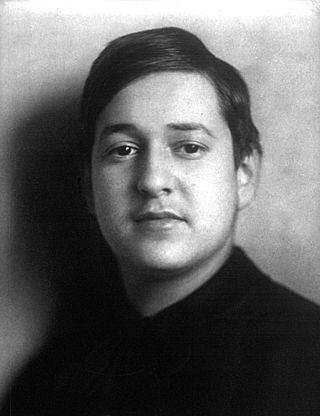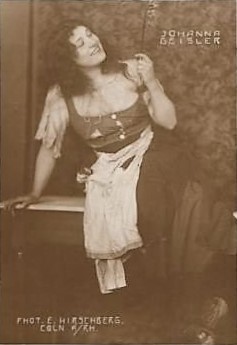
Erich Wolfgang Korngold was an Austrian composer and conductor, who fled Europe in the mid-1930s and later adopted US nationality. A child prodigy, he became one of the most important and influential composers in Hollywood history. He was a noted pianist and composer of classical music, along with music for Hollywood films, and the first composer of international stature to write Hollywood scores.

Julius Leopold Korngold was an Austrian music critic. He was the leading critic in early twentieth century Vienna, serving as chief music critic of the Neue Freie Presse from 1904 to 1934. His son was the composer Erich Wolfgang Korngold, whom he named after Wolfgang Amadeus Mozart, one of his favorite composers.

Maria Jeritza was a dramatic soprano, long associated with the Vienna State Opera and the Metropolitan Opera. Her rapid rise to fame, beauty and personality earned her the nickname "The Moravian Thunderbolt".

Aria is a 1987 British anthology film produced by Don Boyd that consists of ten short films by ten different directors, each showing the director's choice of visual accompaniment to one or more operatic arias. There is little or no dialogue from the actors, with most words coming from the libretto of the operas in Italian, French, or German.
Bruges-la-Morte is a short novel by the Belgian author Georges Rodenbach, first published in 1892. The novel is notable for two reasons: it was the archetypal Symbolist novel, and was the first work of fiction illustrated with photographs.
"Glück, das mir verblieb" is a duet from the 1920 opera Die tote Stadt composed by Erich Wolfgang Korngold to a libretto by his father Julius Korngold. It is written for soprano and tenor. Also called "Marietta's Lied" or the "Lute Song", it appears in act 1, scene 5. In performances as a concert aria, the soprano will sing both parts.

Maria Olszewska was a German operatic dramatic contralto.
Carol Lee Neblett was an American operatic soprano.

Das Wunder der Heliane, Op. 20 is an opera in three acts by Erich Wolfgang Korngold, about "the redemptive power of love over injustice and adversity". The libretto was by Hans Müller-Einigen, after Hans Kaltneker. It was first performed at the Hamburg State Opera on 7 October 1927. A suite for violin and piano based on the music from its famous aria "Ich ging zu ihm" was published by Schott.
Meagan Miller is an American soprano with an active international career in opera, recital and concert.

Violanta, Op. 8, is a one-act opera by Erich Wolfgang Korngold. The libretto is by the Austrian playwright Hans Müller-Einigen. It is Korngold's second opera, written when he was seventeen years old.
Russell Keable is a British educator, composer and conductor. Keable studied conducting at the Royal College of Music with Norman Del Mar and later with George Hurst. Since 1983, he has been the principal conductor of London's Kensington Symphony Orchestra, and since 2006, the principal conductor of the University of Surrey's University Symphony Orchestra and Choir. Since 2006, Keable has taught conducting at the University of Surrey.
Gil Rose is the founder and conductor of the Boston Modern Orchestra Project (BMOP), founder and General-Artistic Director of Odyssey Opera, Artistic Director of Monadnock Music Festival, Professor of Practice at Northeastern University, and Executive Producer of the record label "BMOP/sound."
Erich Wolfgang Korngold's Piano Concerto for the Left Hand in C-sharp major, Op. 17, was written on commission from Paul Wittgenstein in 1923, and published in 1926. It was only the second such concerto ever written, after the Concerto in E-flat by Géza Zichy, published in 1895.
Jaroslav Kyzlink,, is a Czech conductor, who was appointed the music director of the National Theatre in Prague, in August 2012.
Kurt Horres was a German stage director, particularly of opera, and opera manager. He held positions as general manager at the Staatstheater Darmstadt, the Hamburg State Opera, and from 1986 to 1996 at the Deutsche Oper am Rhein. He focused on opera of the 20th century, including composers who had been banned during the Nazi regime, such as Korngold's Die tote Stadt, and literature operas including Gottfried von Einem's Kabale und Liebe, and the world premieres of Blacher's Yvonne, Prinzessin von Burgund, and Klebe's Das Mädchen aus Domrémy. He taught stage direction at the Folkwang University.

Siegfried Trebitsch (1868–1956) was an Austrian playwright, translator, novelist and poet. Though prolific as a writer in various genres, he was best known for his German translations, especially of the works of the Irish playwright George Bernard Shaw, with whom he kept up a long and detailed correspondence. He is also known for translations of French writers, especially Georges Courteline.

Camilla Nylund is a Finnish operatic soprano. She appears internationally in lyric-dramatic roles such as Beethoven's Leonore, Verdi's Elisabetta, and Wagner's Elisabeth and Sieglinde. She is especially known for portraying leading female characters in operas by Richard Strauss,. She has appeared at international festivals and the openings of the Dresdner Frauenkirche and the Elbphilharmonie.
Yoel Gamzou is an Israeli-American conductor and composer, known for works by Gustav Mahler, especially his completion of Mahler's Symphony No. 10. He has been music director at the Theater Bremen from 2017, and has conducted at major European opera houses.

Johanna Geisler, or Geissler, was a German operatic soprano and stage actress. She also appeared as Johanna Klemperer and under stage names Johanna Klee and Hanne Klee. She began her career as a member of the opera chorus of the Hofoper Hannover in 1903, and had a solo engagement at the Mainz Municipal Theatre from 1912. She moved on to the Cologne Opera where she met her future husband, the conductor Otto Klemperer. With him, she performed lead roles including Marietta in the world premiere of Korngold's Die tote Stadt in 1920. She followed him to the Kroll Oper in Berlin in 1927. When he had to leave Germany in 1933, she and the children followed, to Zürich, to Los Angeles from 1935 to 1947, then Budapest, and finally Zürich again.












